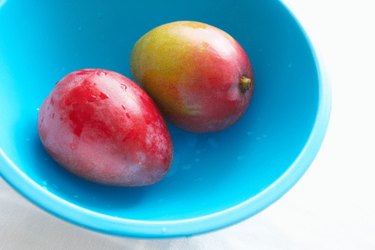
The mango tree (Mangifera indica L.) produces an exotic, tasty fruit that is coveted for its quality as a food source. Both home gardeners and commercial growers must pay close attention to their climates when planting a mango tree if they ever expect to taste the sweet fruit.
USDA Hardiness Zones
Video of the Day
The mango tree originated in southern Asia, specifically eastern India and Burma. It thrives only in tropical locales and will not survive exposure to cold conditions. In the United States, the tree is unlikely to survive winter temperatures in areas outside of U.S. Department of Agriculture hardiness zone 10, a sector that includes south Florida, the extreme southern tip of Texas, a patch of southern California, and Hawaii.
Video of the Day
Minimum Temperature
Mature mango trees can withstand air temperatures to as low as 25 degrees Fahrenheit for only a few hours before injury to leaves and branches is expected. Young trees are likely to die when the temperature drops to 30 F, according to University of Florida Extension. Tender flowers and small fruits may be damaged or die and drop off when exposed to a temperature of 40 F for even a few hours.
Environment
The ideal climate for mango cultivation also offers rainfall of between 30 and 100 inches annually. However, it is important that that rainfall occur during the four summer months, ideally June through September, followed by a dry season of eight months. The mango adapts to a variety of soil conditions provided it is well-drained. When planting in a home landscape, make sure it is located in a well-protected section of the yard, preferably the south or east side of a building.
Winter Protection
Clearly, winter frost protection is vital for the outdoor mango tree. Texas A&M University suggests placing soil banks around a young tree trunk as a barrier against wind and snow. The barrier should be erected by December and not removed until late March. When faced with an imminent cold spell, young trees can also be covered with a blanket, the corners pulled outward and anchored to the ground. When living in areas on the fringe of the mango tree's ability to survive cold, gardeners should grow immature trees in containers and transport the tree indoors for the winter.
- University of Florida Extension; Mango Growing in the Florida Home Landscape; Jonathan H. Crane, et al.
- Purdue University Department of Horticulture; Mango; Julia F. Morton; 1987
- Texas A&M University; Home Fruit Production: Mango; Julian W. Sauls
- U.S. National Arboretum: USDA Plant Hardiness Zone Map